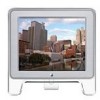Apple M7649ZM User Manual - Page 25
Environmental Protection Agency's ENERGY STAR program. Look for the EPA ENERGY STAR
 |
UPC - 718908472613
View all Apple M7649ZM manuals
Add to My Manuals
Save this manual to your list of manuals |
Page 25 highlights
Conserving Energy You can use the Energy Saver control panel to set the monitor to conserve energy after a specified period of inactivity. Note: You can save even more energy by turning the monitor off if you won't be using it for a while-for example, overnight or over the weekend. You can use Energy Saver with any Apple monitor that complies with the United States Environmental Protection Agency's ENERGY STAR program. (Look for the EPA ENERGY STAR logo on the monitor box.) For more information about power-saving and environmental features, see "Power-Saving and Environmental Features" on page 33 of this manual and the document named "TCO 95 Information" on the CD that came with your monitor. What Happens After You Turn On the Energy-Saving Feature? When Energy Saver detects that you're not using the computer, it darkens the monitor screen and reduces the amount of energy it consumes. While the monitor is darkened, your computer is still working, but to avoid accidental changes, Energy Saver won't let any typing or mouse movement affect any of your work. To "wake up" the monitor, press any key on the keyboard. Your computer may beep while the monitor is waking up. You can begin work as soon as the computer stops beeping. (The beep volume cannot be adjusted.) Important If you use Energy Saver, make sure you turn it off when you're doing diskintensive tasks such as copying a large number of files, downloading large files from an online service, or printing a very large file. If Energy Saver is activated during such a task, the task may stop prematurely and you may need to recopy or reprint a file. Setting Up Energy Saver For instructions about setting up Energy Saver, see Mac OS Help. Using Energy Saver With a Screen Saver Screen savers are applications you can purchase that put moving patterns on your monitor when you're not using your mouse or keyboard. Screen savers and Energy Saver both help prevent screen "burn-in" (a problem in which ghost images remain on the monitor screen if it displays the same image for a long period of time). Energy Saver also conserves energy. Using the Apple Displays Software 25















